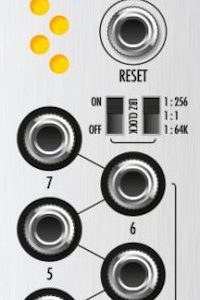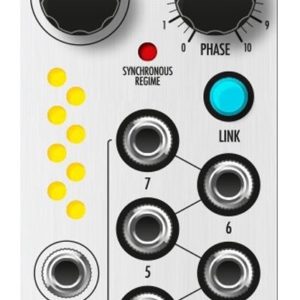Description
BINARY PRODUCT COMMANDER
MODEL OF 1989
Gera is a component of the Leibniz Binary Subsystem. It works by processing data in the Leibniz bus and requires a connection to other Leibniz modules. It features eight individual gate inputs that affect the corresponding individual bits of the Leibniz data. Eight illuminated tact switches allow for manual inverting of each gate input. The primary function of Gera is masking individual bits of the digital data through the AND operation. For example, when connected to Drezno, which is processing a waveform or voltage, masking individual bits yields various forms of quantization. However, Gera does not need Drezno to work. The AND operation is also a basic building block for sequence automation, chaos and rhythm generation, and various cybernetic modular patches. Bit processing logic in Gera is hardware-based; hence there is virtually no latency, and the binary signals may change at extreme rates. For detailed description, please refer to the manual.
FEATURES
- Leibniz Binary Subsystem component
- Logical AND operation on Leibniz data
- Masking of individual bits controlled manually and by gate signals
- Visual indication by illuminated buttons
TECH SPECS
- 6hp, skiff friendly
- Current draw: +60mA / -0mA
- NOT protected against plugging power to Leibniz headers!
EXPANDABILITY
Drezno is the input/output front-end of the system, consisting of an analog–to–digital converter (ADC) and a digital–to–analog converter (DAC), that alone can be used for manipulating analog signals and voltages based on their binary representation.
Lipsk is a binary logic processing expander module that can flip (invert) individual bits of the digital signal representation.
Jena is a digital module that may be used as a flexible waveshaper for CV and audio signals, a wavetable oscillator, a Walsh function generator, or a rhythm generator.
Erfurt is a bi-directional digital counter, frequency divider. It has multiple applications: the output of the counter may be used as a phase source driving a digital wavetable, connected to other Leibniz modules it may scan waveshapes in Jena, produce stepped voltages useful for making interesting glissandi with Drezno and any VCO, generate gate patterns animating the spectrum of Odessa harmonic banks, spawn pseudo-chaotic sequences when fed back to Lipsk, etc.
Poczdam is a binary data routing solution for the Xaoc Leibniz Subsystem. It facilitates manual and remote switching between two Leibniz data sources.
DEMOS & TUTORIALS





